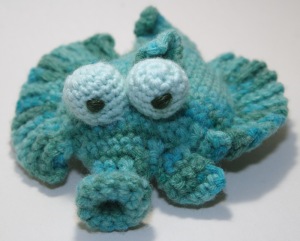Arrrgh, I just realized that I never showed y’all my Mini-Mapes! Inconceivable!
Deciding what yarn to use to knit the prototype for Mapes was a head scratcher. Part of me really wanted to use Malabrigo Worsted or Rios, but the madelinetosh just kinda jumped off the shelf and said Pick Me, Pick Me and it was done. But then came entering the pattern into the Ravelry database and the conundrum of deciding what yarns to suggest.
I don’t know that this pattern would work well with lace-weight yarn or a super chunky, but anything in between is pretty fair game. So it was thinking cap time. Being a “knit as long as you have yarn” type pattern it lends itself well to yarns with large or unusual yardage per skein. With the combination of garter, stockinette and textural elements – it is specifically designed to work well with variegated colorways.
Think, think, think.
Right off, and obviously – fancy pants colors + mega-yardage = Wollmeise. Pretty much a no brainer. Now I have listed a worsted (the tosh) and a fingering weight. My need for balance insisted that I add a sport or DK weight.
Think, think, think.
Eureka, I say to myself. How awesome would this look in Malabrigo Silky Merino? Super Awesome. Which rounded out my yarn suggestions and allowed me to proceed. But it also planted a little idea in my head.
An idea I couldn’t shake.
What would a single skein of the Silky look like? Only 150 yards of DK. I have said any yarn, any size for this shawl – how far can I push this?

Well, it looks like this!
I held off casting on for 2 whole days. I do have other things that I should be doing, but I couldn’t stand it. First I created a project page and hoped that would be enough – but it wasn’t. 2 days after casting on I had my Mini-Mapes. And I think it is crazy cute.

Bandito style.
It isn’t big enough to be a proper shawl (or even shawlette) but it works nicely as a kerchief or a cowl substitute on an adult. But it is also the perfect size to be a child’s shawl. My son (who is almost 5) was a relatively cooperative subject for the photographs – but I would love to see this on a pretty princess. Because it’s pinkness screams for a pretty princess.

He is such a good sport, isn't he?
Curiosity satisfied. And as an added bonus I got to try out the texture stitch from Mapes that I didn’t use in the protype. It gives a very different effect – but I really dig it’s look.

This is the YO texture option - worked non-alternating.
Want to knit this? Check it out on Ravelry or 









